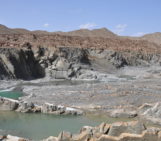
Dahlen 1990‘s paper presents a synthesis of all theoretical work on accretionary wedges that had begun more than a decade earlier, with the fold and thrust belts research of Elliott (1976), Chapple (1978), and model by Davis et al., (1983). Dahlen expanded previous views with a more sophisticated treatment of pore-fluid pressure using volume-averaged Stokes-equations for both solids and fluids in the accretionary wedge. As a result, he not only accounted for the seepage force, but also made an explicit distinction between aggregate, solid, and effective stresses in the wedge. Later in the paper, Dahlen meticulously integrates these formulations into the Coulomb failure criterion and elaborates on the precise numerical derivation of the model, also for non-cohesive coulomb wedges, including their fluid pressure distribution. Following that, the paper describes a general theory for thin-skinned wedges that accounts for spatial variations in porosity, pore-fluid pressure, and several other parameters. Moreover, the article also carefully considers special cases, like those of the presence of extremely weak materials such as salt in decollement, heat flow anomaly due to friction heating in the wedge, and the brittle-plastic transition, that limits the height of wide wedges. The article concludes by emphasizing the significance of integrating hydrological models with the critical taper theory.

Figure 1: Accretionary wedge structure in Taiwan. From Dahlen (1990)
The critical taper paradigm, as stated by Dahlen in the article, is “for understanding the large scale mechanics of fold-and-thrust belts and accretionary wedges.” Therefore, it does not provide a clear description of the wedge inner smaller-scale changes. This leads to a lack of precision of these processes in orogenic wedges, such as thrusting placement, underthrusting and out-of-sequence faults, the motion of rock units, local changes in surface processes, and the nature of décollement. Classic articles and more recent numerical efforts have highlighted the changes in wedge architecture due to the latter factors, such as local changes in surface processes and basal topography; see Morley (1988) out-of-sequence thrusts, Platt (1986) underplating, and Willett (1992) bivergent orogens, as well as Dominguez et al. (2000), Simpson (2010), Fillonet al. (2012), and Ruh (2020).

Figure 2: Accretionary wedge structure in Taiwan. From Chen et. al. (2018).
As Dahlen pointed out, integrating hydrological models of pore-fluid pressures with the critical taper model is a logical next step. Perhaps surprisingly, this is still an open question. Arguably, the most significant ramification of this integration could be the dynamic evolution of the décollement layer in wedges.
Comments by David Fernández-Blanco, Saurabh Chaubey, and Utsav Mannu unanimously support Dahlen’s paper as an essential must-read for students of subduction zone geodynamics. The discussion in the comments reiterated the paper to be the most complete, with every formulation well explained.
Written by Utsav Mannu, David Fernández-Blanco, Benoit Petri, and the TS Must Read team
References
Chapple, W. M. (1978). Mechanics of thin-skinned fold-and-thrust belts. Geological Society of America Bulletin, 89(8), 1189-1198.
Chen, C. T., Chan, Y. C., Lo, C. H., Malavieille, J., Lu, C. Y., Tang, J. T., & Lee, Y. H. (2018). Basal accretion, a major mechanism for mountain building in Taiwan revealed in rock thermal history. Journal of Asian Earth Sciences, 152, 80-90.
Dahlen, F. A. (1990). Critical taper model of fold-and-thrust belts and accretionary wedges. Annual Review of Earth and Planetary Sciences, 18(1), 55-99.
Davis, D., Suppe, J., & Dahlen, F. A. (1983). Mechanics of fold‐and‐thrust belts and accretionary wedges. Journal of Geophysical Research: Solid Earth, 88(B2), 1153-1172.
Dominguez, S., Malavieille, J., & Lallemand, S. E. (2000). Deformation of accretionary wedges in response to seamount subduction: Insights from sandbox experiments. Tectonics, 19(1), 182-196.
Elliott, D. (1976). The motion of thrust sheets. Journal of Geophysical research, 81(5), 949-963.
Fillon, C., Huismans, R. S., & van der Beek, P. (2013). Syntectonic sedimentation effects on the growth of fold-and-thrust belts. Geology, 41(1), 83-86.
Morley, C. K. (1988). Out‐of‐sequence thrusts. Tectonics, 7(3), 539-561.
Platt, J. P. (1986). Dynamics of orogenic wedges and the uplift of high-pressure metamorphic rocks. Geological society of America bulletin, 97(9), 1037-1053.
Ruh, J. B. (2020). Numerical modeling of tectonic underplating in accretionary wedge systems. Geosphere, 16(6), 1385-1407.
Simpson, G. D. (2010). Formation of accretionary prisms influenced by sediment subduction and supplied by sediments from adjacent continents. Geology, 38(2), 131-134.
Willett, S. D. (1992). Dynamic and kinematic growth and change of a Coulomb wedge. In Thrust tectonics (pp. 19-31). Springer, Dordrecht.


